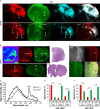5-aminolevulinic acid, fluorescein sodium, and indocyanine green for glioma margin detection: analysis of operating wide-field and confocal microscopy in glioma models of various grades
- PMID: 37287908
- PMCID: PMC10242067
- DOI: 10.3389/fonc.2023.1156812
5-aminolevulinic acid, fluorescein sodium, and indocyanine green for glioma margin detection: analysis of operating wide-field and confocal microscopy in glioma models of various grades
Abstract
Introduction: Surgical resection remains the first-line treatment for gliomas. Several fluorescent dyes are currently in use to augment intraoperative tumor visualization, but information on their comparative effectiveness is lacking. We performed systematic assessment of fluorescein sodium (FNa), 5-aminolevulinic acid (5-ALA)-induced protoporphyrin IX (PpIX), and indocyanine green (ICG) fluorescence in various glioma models using advanced fluorescence imaging techniques.
Methods: Four glioma models were used: GL261 (high-grade model), GB3 (low-grade model), and an in utero electroporation model with and without red fluorescence protein (IUE +RFP and IUE -RFP, respectively) (intermediate-to-low-grade model). Animals underwent 5-ALA, FNa, and ICG injections and craniectomy. Brain tissue samples underwent fluorescent imaging using a wide-field operative microscope and a benchtop confocal microscope and were submitted for histologic analysis.
Results: Our systematic analysis showed that wide-field imaging of highly malignant gliomas is equally efficient with 5-ALA, FNa, and ICG, although FNa is associated with more false-positive staining of the normal brain. In low-grade gliomas, wide-field imaging cannot detect ICG staining, can detect FNa in only 50% of specimens, and is not sensitive enough for PpIX detection. With confocal imaging of low-intermediate grade glioma models, PpIX outperformed FNa.
Discussion: Overall, compared to wide-field imaging, confocal microscopy significantly improved diagnostic accuracy and was better at detecting low concentrations of PpIX and FNa, resulting in improved tumor delineation. Neither PpIX, FNa, nor ICG delineated all tumor boundaries in studied tumor models, which emphasizes the need for novel visualization technologies and molecular probes to guide glioma resection. Simultaneous administration of 5-ALA and FNa with use of cellular-resolution imaging modalities may provide additional information for margin detection and may facilitate maximal glioma resection.
Keywords: 5-aminolevulinic acid; fluorescein sodium; fluorescence guided surgery; glioma; indocyanine green; laser scanning microscopy; protoporphyrin IX.
Copyright © 2023 Belykh, Bardonova, Abramov, Byvaltsev, Kerymbayev, Yu, Healey, Luna-Melendez, Deneen, Mehta, Liu and Preul.
Conflict of interest statement
The authors declare that the research was conducted in the absence of any commercial or financial relationships that could be construed as a potential conflict of interest.
Figures







Similar articles
-
Scanning Fiber Endoscope Improves Detection of 5-Aminolevulinic Acid-Induced Protoporphyrin IX Fluorescence at the Boundary of Infiltrative Glioma.World Neurosurg. 2018 May;113:e51-e69. doi: 10.1016/j.wneu.2018.01.151. Epub 2018 Feb 2. World Neurosurg. 2018. PMID: 29408716 Free PMC article.
-
Intraoperative confocal laser endomicroscopy during 5-aminolevulinic acid-guided glioma surgery: significant considerations for resection at the tumor margin.J Neurosurg. 2024 Sep 27;142(2):429-442. doi: 10.3171/2024.5.JNS24140. Print 2025 Feb 1. J Neurosurg. 2024. PMID: 39332037
-
Quantitative fluorescence using 5-aminolevulinic acid-induced protoporphyrin IX biomarker as a surgical adjunct in low-grade glioma surgery.J Neurosurg. 2015 Sep;123(3):771-80. doi: 10.3171/2014.12.JNS14391. Epub 2015 Jul 3. J Neurosurg. 2015. PMID: 26140489 Free PMC article.
-
5-ALA in Suspected Low-Grade Gliomas: Current Role, Limitations, and New Approaches.Front Oncol. 2021 Jul 30;11:699301. doi: 10.3389/fonc.2021.699301. eCollection 2021. Front Oncol. 2021. PMID: 34395266 Free PMC article. Review.
-
Characteristics of Fluorescent Intraoperative Dyes Helpful in Gross Total Resection of High-Grade Gliomas-A Systematic Review.Diagnostics (Basel). 2020 Dec 16;10(12):1100. doi: 10.3390/diagnostics10121100. Diagnostics (Basel). 2020. PMID: 33339439 Free PMC article. Review.
Cited by
-
Whole-body fluorescence cryotomography identifies a fast-acting, high-contrast, durable contrast agent for fluorescence-guided surgery.Theranostics. 2024 Oct 7;14(17):6426-6445. doi: 10.7150/thno.100802. eCollection 2024. Theranostics. 2024. PMID: 39479457 Free PMC article.
-
Comparison of 5-aminolevulinic acid and MMP-14 targeted peptide probes in preclinical models of GBM.Theranostics. 2025 Feb 24;15(8):3517-3531. doi: 10.7150/thno.107210. eCollection 2025. Theranostics. 2025. PMID: 40093889 Free PMC article.
-
Elucidating the effect of tumor and background region-of-interest selection on the performance metrics used to assess fluorescence imaging.J Biomed Opt. 2025 Apr;30(4):046004. doi: 10.1117/1.JBO.30.4.046004. Epub 2025 Apr 2. J Biomed Opt. 2025. PMID: 40177378 Free PMC article.
-
Comparing spatial distributions of ALA-PpIX and indocyanine green in a whole pig brain glioma model using 3D fluorescence cryotomography.J Biomed Opt. 2025 Jan;30(Suppl 1):S13704. doi: 10.1117/1.JBO.30.S1.S13704. Epub 2024 Sep 6. J Biomed Opt. 2025. PMID: 39247519 Free PMC article.
-
Automated online safety margin (GLIOVIS) for glioma surgery model.Front Oncol. 2024 Apr 29;14:1361022. doi: 10.3389/fonc.2024.1361022. eCollection 2024. Front Oncol. 2024. PMID: 38741783 Free PMC article.
References
-
- Zhao S, Wu J, Wang C, Liu H, Dong X, Shi C, et al. . Intraoperative fluorescence-guided resection of high-grade malignant gliomas using 5-aminolevulinic acid-induced porphyrins: a systematic review and meta-analysis of prospective studies. PloS One (2013) 8(5):e63682. doi: 10.1371/journal.pone.0063682 - DOI - PMC - PubMed
-
- Stummer W, Pichlmeier U, Meinel T, Wiestler OD, Zanella F, Reulen HJ, et al. . Fluorescence-guided surgery with 5-aminolevulinic acid for resection of malignant glioma: a randomised controlled multicentre phase III trial. Lancet Oncol (2006) 7(5):392–401. doi: 10.1016/S1470-2045(06)70665-9 - DOI - PubMed
LinkOut - more resources
Full Text Sources

